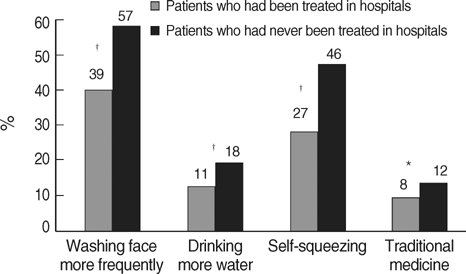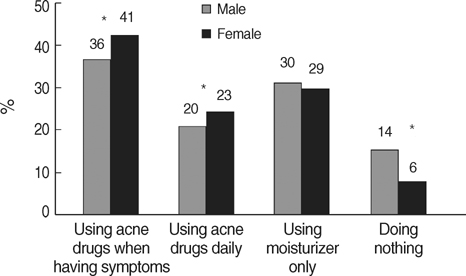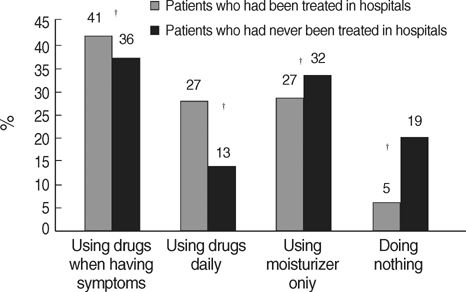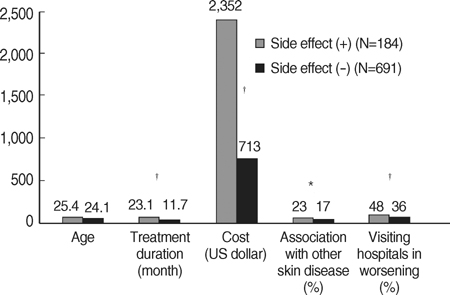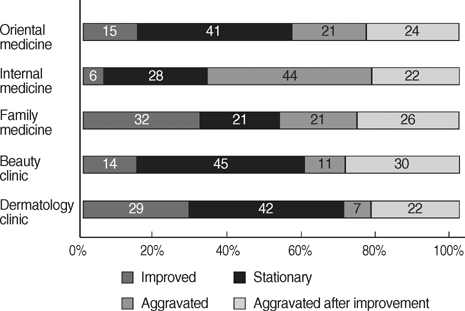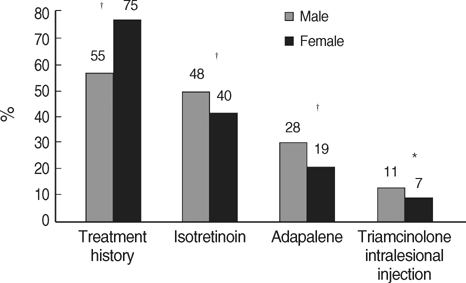J Korean Med Sci.
2008 Dec;23(6):969-974. 10.3346/jkms.2008.23.6.969.
Treatment-Seeking Behaviors and Related Epidemiological Features in Korean Acne Patients
- Affiliations
-
- 1Department of Dermatology, Seoul National University College of Medicine, Seoul, Kotea. daehun@snu.ac.kr
- 2Acne Research Laboratory, Seoul National University Hospital, Seoul, Korea.
- 3Department of Dermatology, College of Medicine, Kyunghee University, Seoul, Korea.
- 4Department of Dermatology, College of Medicine, Korea University, Seoul, Korea.
- 5Department of Dermatology, Sungkyunkwan University School of Medicine, Seoul, Korea.
- 6Department of Dermatology, Hanyang University Medical College, Seoul, Korea.
- 7Department of Dermatology, Hallym University Medical College, Anyang, Korea.
- KMID: 1107519
- DOI: http://doi.org/10.3346/jkms.2008.23.6.969
Abstract
- Little is known about the treatment-seeking behaviors of acne patients, especially Asian acne patients. This study was performed to obtain detailed information about the treatment-seeking behaviors in Korean acne patients. Patients who visited the dermatology departments at 17 university hospitals completed a self-administered questionnaire. Most patients obtained information about acne from doctors or the Internet. The most important criteria for selecting a treatment method or choosing a particular clinic were effectiveness and accessibility. Patients used traditional medicine, visited beauty clinics, drank more water, and used over-the-counter topical agents more frequently than they sought doctors during the worsening period. The degree of satisfaction in treatment was found to depend on the total cost of treatment, number of places visited, site affected by acne, and emotional stress. Those who had experienced a side effect tended to have been treated for longer, to have paid more for treatment, and to have an associated skin disease. Treatments prescribed by dermatology clinics had the lowest aggravating rate, although improvement rates for family medicine clinics were also fairly high. This is the first study to investigate in detail the demographic features and characteristics of the treatmentseeking behaviors of acne patients in Asia.
Keyword
MeSH Terms
Figure
Cited by 1 articles
-
Pharmacologic Treatment of Acne
Dae Hun Suh
J Korean Med Assoc. 2010;53(7):623-629. doi: 10.5124/jkma.2010.53.7.623.
Reference
-
1. Collier CN, Harper JC, Cantrell WC, Wang W, Foster KW, Elewski BE. The prevalence of acne in adults 20 years and older. J Am Acad Dermatol. 2008. 58:56–59.
Article2. Layton AM, Henderson CA, Cunliffe WJ. A clinical evaluation of acne scarring and its incidence. Clin Exp Dermatol. 1994. 19:303–308.
Article3. Smithard A, Glazebrook C, Williams HC. Acne prevalence, knowledge about acne and psychological morbidity in mid-adolescence: a community-based study. Br J Dermatol. 2001. 145:274–279.
Article4. Goulden V, Stables GI, Cunliffe WJ. Prevalence of facial acne in adults. J Am Acad Dermatol. 1999. 41:577–580.
Article5. Cunliffe WJ, Gould DJ. Prevalence of facial acne vulgaris in late adolescence and in adults. Br Med J. 1979. 1:1109–1110.
Article6. Yeung CK, Teo LH, Xiang LH, Chan HH. A community-based epidemiological study of acne vulgaris in Hong Kong adolescents. Acta Derm Venereol. 2002. 82:104–107.
Article7. Tan HH, Tan AW, Barkham T, Yan XY, Zhu M. Community-based study of acne vulgaris in adolescents in Singapore. Br J Dermatol. 2007. 157:547–551.
Article8. Sung KJ, Rho YS, Choi EH, Oh JJ, Lee JH, Kim SW, Kim NI. Korean Acne Grading System. Korean J Dermatol. 2004. 42:1241–1247.9. Cho YJ, Lee DH, Hwang EJ, Youn JI, Suh DH. Analytic study of the patients registered at Seoul National University acne clinic. Korean J Dermatol. 2006. 44:978–804.10. Tan JK, Vasey K, Fung KY. Beliefs and perceptions of patients with acne. J Am Acad Dermatol. 2001. 44:439–445.
Article11. Pearl A, Arroll B, Lello J, Birchall NM. The impact of acne: a study of adolescents' attitudes, perception and knowledge. N Z Med J. 1998. 111:269–271.12. Nijsten T, Rombouts S, Lambert J. Acne is prevalent but use of its treatment is infrequent among adolescents from the general papulation. J Eur Acad Dermatol Venereol. 2007. 21:163–168.
Article13. Smithard A, Glazebrook C, Williams HC. Acne prevalence, knowledge about acne and psychological morbidity in mid-adolescence: a community-based study. Br J Dermatol. 2001. 134:274–279.
Article14. Kang MJ, Hahm JH. Comparative study of acne on clinical features and patient understandings in adolescence and post-adolescence. Korean J Dermatol. 2000. 38:589–599.15. Lee SH, Park TH, Kang WH, Whang KK, Lee CW, Sung KJ, Ahn SK, Park JK. A statistical analysis of acne patients who visited university hospitals recently. Korean J Dermatol. 1996. 34:386–393.16. Rapp DA, Brenes GA, Feldman SR, Fleischer AB Jr, Graham GF, Dailey M, Rapp SR. Anger and acne: implications for quality of life, patient satisfaction and clinical care. Br J Dermatol. 2004. 151:183–189.
Article
- Full Text Links
- Actions
-
Cited
- CITED
-
- Close
- Share
- Similar articles
-
- An Inquiry to the Casual Perceptions and Health seeking Behaviors of Rheumatoid Arthritis Patients
- Analytic Study of the Patients Registered at Seoul National University Hospital Acne Clinic
- Decreased Health-Seeking Behaviors in People With Depressive Symptoms: The Korea National Health and Nutrition Examination Survey 2014, 2016, and 2018
- A Survey to Understand Acne Patients in Busan
- Korean Acne Grading System


